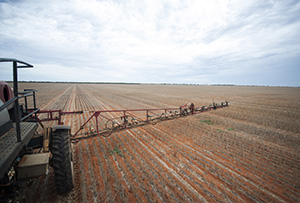
With glyphosate prices on the rise and weeds of all kinds expected to be an issue after rainfall events, Australian grain growers should consider a summer weed management strategy as a matter of priority.
Weeds present one of the biggest costs to growers, so investing in proactive management can help maintain profitability and preserve soil moisture for the 2022 winter cropping season.
ICAN Senior Consultant, Mark Congreve, whose work is supported by GRDC investment, said spraying weeds when they’re young is the most effective way to control them and the best way to ensure growers get the maximum value from their herbicides.
Mr Congreve said with high populations of weeds and rising glyphosate prices, growers should be discussing management options with their advisers and implementing targeted strategies to get the best results.
Here are some things to consider when implementing a summer weed management strategy:
Weed identification:
Mr Congreve said the first step to tackling early weed emergence was identifying weed species and determining their resistance levels from prior testing and paddock observations based on the level of control from previous spray applications. This significantly influences management options, herbicide selection and other application factors such as dose rates, droplet size and sprayer set up.
GRDC’s Common Weeds of Grain Cropping Ute Guide encourages the identification of weed species as a priority to ensure correct management decisions are made in a timely and cost-effective manner. Correct identification of weeds allows the correct choice of herbicides management tactics.
Optimal glyphosate application:
It’s common for growers to consider what other mixing partners they should add to their glyphosate applications when paddocks have established weeds. However, Mr Congreve said the best way to maximise glyphosate efficiency was to apply it straight, under optimal conditions.
“Growers should try to avoid mixing glyphosate where possible, as other herbicides can often hinder its performance,” he said.
“In particular, mixes with Group 4 (I) herbicides such as 2,4-D and fluroxypyr can be antagonistic for control of glyphosate resistant grasses and broadleaf weeds, such as sow thistle, under summer application conditions.”
“Group 14 (G) herbicides may also reduce glyphosate performance when mixed and applied under high light intensity conditions.”
Adding mixing partners to glyphosate can be effective when weeds are small and glyphosate susceptible, but Mr Congreve said negative interactions are more likely to occur when dealing with resistant weeds.
Mr Congreve said if growers are unable to apply herbicide under optimal conditions, they’ll need to increase glyphosate rates to compensate.
“This isn’t something growers would want to hear considering high prices but getting a great result the first time could save additional sprays throughout the season.”
Some things to consider when applying glyphosate:
- Use at least coarse to very coarse spray quality for summer glyphosate applications. Larger droplets allow more time for glyphosate to get into the leaf due to slower droplet evaporation.
- Avoid applying under ‘heat wave’ conditions i.e. consecutive days with temperatures in the mid 30s and low humidity, as many species will respond to these conditions by modifying their waxy leaf cuticle to be less receptive to water-based herbicides like glyphosate.
- If spraying must occur in ‘heat wave’ conditions, growers should use the maximum glyphosate rate and apply during the cooler times of the day, allowing at least 4 to 6 hours of leaf uptake before it gets hot
- The application of glyphosate on to dusty, soil covered leaves can reduce its efficacy as the herbicide strongly binds to soil particles.
- Growers should strongly consider the addition of ammonium sulphate when using glyphosate, to both improve water quality for spraying and to assist with uptake of the glyphosate molecule.
Double knock applications:
Mr Congreve recommends a double knock immediately after harvest if paddocks have weeds from the winter crop, or summer weeds emerging.
When dealing with resistant weeds, it’s important growers use a second knock that’s able to control any weeds that survived the first pass.







